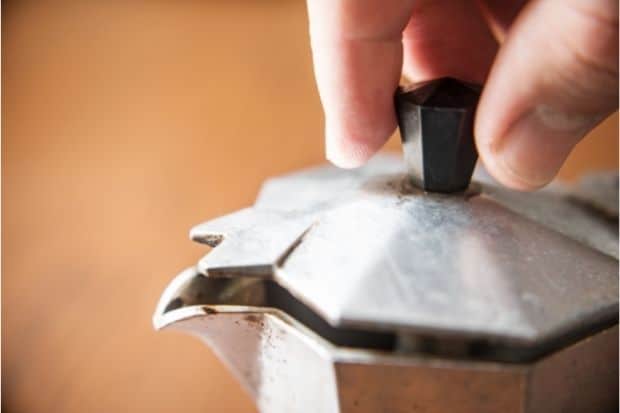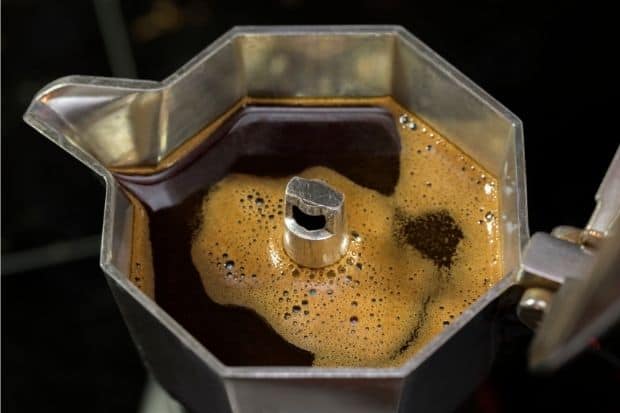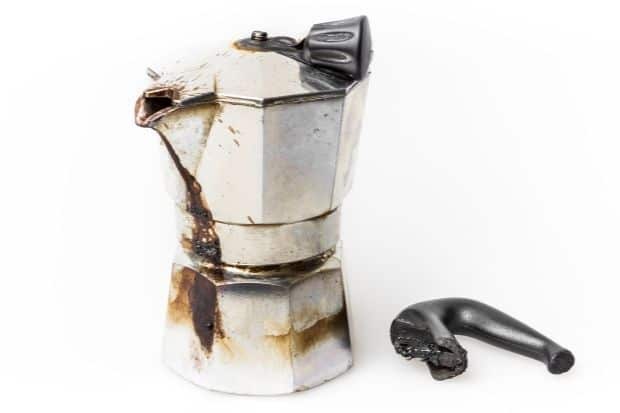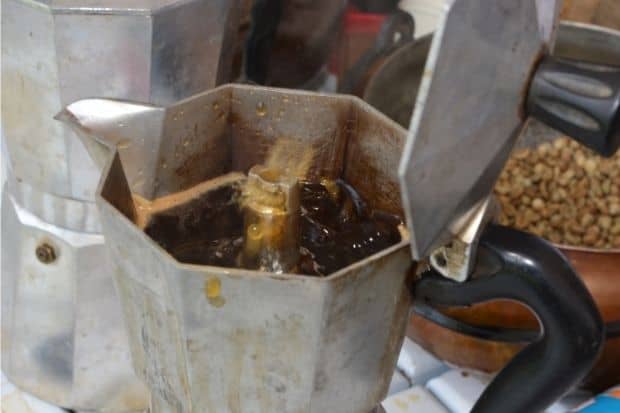Just so you know, as an Amazon Associate we earn from qualifying purchases made via bold red links, buttons or images.
Last Updated on December 3, 2023
Moka pots are a simple, traditional way for coffee drinkers to brew an intense, rich cup of coffee on the stove or even over an open flame while camping.
The humble design of the moka pot is so effective, little about it has changed since it was first introduced by Alfonso Bialetti in 1933.
When cleaned and used properly, your moka pot will deliver a delicious cup of coffee for years, but sputtering is a common issue that can arise.

Why Is My Moka Pot Sputtering?
If your moka pot is sputtering, it is likely due to debris, incorrect pressure, or your brewing process. All are simple fixes.
Sputtering at the end of your brew is perfectly normal, and is actually the sign that your coffee is ready. As soon as you hear that sputtering sound, remove your moka pot from the heat source, as overheating can lead to a burnt and bitter taste. (Who wants bitter coffee?)
If visible sputtering or a sputtering sound occurs throughout the process, or you end up with only a small amount of coffee in your upper chamber, you’ve got an issue. Not to worry, though. There are simple ways to address moka pot sputtering. We’ll break them down in detail and lay out simple and effective ways to reduce or eliminate sputtering from your moka pot routine.
How Your Moka Pot Works
Before we address the reasons you might be experiencing sputtering, it’s important to discuss how your moka pot works. There are three parts to a moka pot: the bottom chamber that you fill with water, the filter basket where you add your coffee grounds, and the top chamber where your brewed coffee collects.
Moka pots utilize pressure, which is attained through heat. As the air in the bottom chamber heats up and expands, pressure builds, forcing the water up through the coffee grounds. Similar to an inverted espresso process (although much slower and with lower pressure), having the right amount of pressure is paramount to the success of your brewing process.
If you want some tips on using your moka pot, see our post on how to use a moka pot to make great coffee.

Common Causes and Simple Solutions
Is Your Moka Pot Clean?
This is the first thing you want to check. If debris or build-up is blocking any area of the coffee maker, you will likely experience sputtering and possibly an inability to effectively complete the brewing process.
Mineral build-up from your water or coffee particles can create an imperfect seal on your moka pot, resulting in air and water leaks, which release pressure and can lead to sputtering. After adding your coffee grounds to the filter basket, always ensure the gasket is free of coffee particles. You can use a small brush, or simply run your finger around the edge to remove any potential spill over.
Moka pots are simple to clean after use. Hot water with a bit of manual friction should be enough for daily cleaning as long as all coffee particles are removed.
Minerals and bits of coffee will build up over time, so it’s important to periodically do a deeper clean, particularly if you’re experiencing sputtering.
How To Clean Your Moka Pot
Every now and then, or if you suspect build-up is causing your moka pot to sputter, it’s a good idea to give it a deeper cleaning. You never want to use harsh detergent, and avoiding soap altogether is best.
- Baking Soda. For a deeper clean mix 1 teaspoon of baking soda with a cup of warm water and use that to thoroughly scrub all parts of your moka pot, rinsing thoroughly.
- Vinegar. Alternatively, make a solution of 1 part vinegar to 3 parts hot water, and soak all parts of your moka pot for about 1 hour. Thoroughly rinse, and run your pot through a brewing cycle without coffee to remove any residual vinegar taste.
How’s Your Pressure?
If cleaning your moka pot doesn’t do the trick, the issue might be the amount of pressure, or your pot’s ability to retain pressure. Sputtering can occur when there is too much pressure or not enough.
Too Much Pressure
The most common cause of excessive pressure is high heat. If you’re tempted to crank the element to get a faster brew time, this could be the source of sputtering. When overheating occurs, extra pressure builds up within your moka pot and will find the path of least resistance for the release of that excess pressure, often resulting in sputtering noises and splashing. Not only is this an ineffective brewing method, but it can also be quite dangerous.

To decrease your coffee brew time slightly, you can start your moka pot on higher heat (medium heat is still preferred) then reduce heat as soon as you hear the water in the lower chamber begin to boil.
Not Enough Pressure
The inverse is also true. Insufficient pressure can also result in sputtering, and there are a few potentials causes.
Faulty or Worn Out Gasket or Safety Valve
If your moka pot isn’t sealing properly, steam and water will leak out, causing it to lose pressure. As mentioned above, the first check should be whether there are any coffee particles around the gasket causing an improper seal, and that you’ve effectively tightened your pot. You shouldn’t need to use excessive force to seal your pot, though. If you do, it’s likely the gasket needs to be replaced.
Your moka pot also has a safety valve that releases steam to control pressure and ensure the safety of your pot. A faulty or worn-out safety valve can unnecessarily release pressure and contribute to sputtering. Luckily, replacement parts for you moka pot are both affordable and extremely easy to source.
Overfilling
Overfilling your lower camber with water can result in a lack of pressure, as a certain amount of air is required for expansion, creating the necessary pressure to force the water up through the filter basket. Most moka pots have a fill line, so ensure you are not overfilling. It’s also important not to underfill your water chamber, as this will result in excessive pressure. It’s not advisable to attempt to make a small amount of coffee with a large capacity moka pot. Given the approachable price point, it can be handy to have a small pot for daily use and a larger pot for entertaining.
How’s Your Grind Size?
The ideal grind size for your moka pot is a medium-fine grind, slightly coarser than an espresso grind. If your grind is too fine, water will struggle to penetrate and pressure will build in the lower chamber. This can cause sputtering, as well as under-extraction and low coffee output. The same can be said for overfilling your grind basket. You want a ratio of approximately 1:7 coffee to water for your moka pot.
You never want to tamp your coffee grinds into the filter basket, either. Moka pots create about 1-2 bars of pressure, in comparison to home espresso machines which typically reach around 15 bars. Your moka pot does not have sufficient pressure to saturate and properly extract tamped grounds, and the result will be similar to using an overly fine grind. Simply scoop in the required grind amount, fill water to the water level fill line, and tightly seal your moka pot for top performance.
Sputtering with New Moka Pots
There are rare cases of new moka pots sputtering from the get go, and it’s typically the result of a brittle gasket, particularly if your pot happened to be on the shelf for a few years. If you’ve adjusted your brewing process and you still experience sputtering with a new unit, check your gasket or exchange your pot.
Final Thoughts
Moka pots are a simple way for a coffee fan to brew a rich and delicious espresso-like coffee at home. When cared for properly they can last for years, especially if you opt for a trusted brand. Bialetti remains top of class for a reason, and they offer a 2-year warranty on their wide range of pots.
The Moka Express is Bialetti’s iconic stovetop espresso maker:
https://m.media-amazon.com/images/I/31uHjVnnPBS._SL500_.jpg
Check availability
If cleaning, adjusting your process, or replacing your gasket fails to reduce your moka pot sputtering, you may need to replace your pot, but hopefully the above steps have you brewing sputter-free and enjoying the beautiful flavor of coffee in no time.


